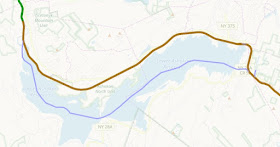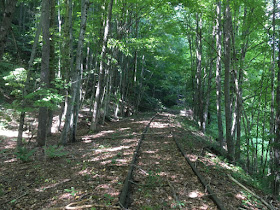The railroad bridge was destroyed in 2011 by Hurricane Irene but its ruins are visible from a Google aerial.
Following the Stream bed
There's no road or path that leads to the bridge but I determined from aerial views that if one follows the stream bed from the nearest road, you will eventually come to the ROW. So we bushwhacked in and had to cross the rocky stream quite a few times.Ruins!
Eventually we came across an old house foundation...... and abutments to a long gone small carriage road bridge.
A 1905 topo map indicated there were houses in the area. As I was hoping to see some old foundation ruins, it was pretty exciting to discover them.
The Right-of-Way (ROW)
Of course, as I anticipated, the railroad ROW was nearby but I was somewhat disappointed to discover all the ties and rails were gone. I had read about the controversy of the county's alleged effort to stymie the operations of the Catskill Mountain Railroad--who were running tourist trains on the track before the bridge was destroyed. There was a concerted effort to turn it into a rail trail instead. Much as I love rail trails, I was hoping to discover tracks still here not just a gravel bed. Oh well--I guess I will have to mountain bike it next time...
We walked eastward for a bit and came across occasional tie plates and......Mike picked up a piece of a railroad tie.
It was kinda cool to find a mile marker - I believe that signifies 21 miles from Kingston (where the line originated).
I was hoping to locate where the prior route of the ROW branched off (blue line) but after decades of nature's regrowth I never found it (see About the Railroad below for further details).
Once we got to the causeway section and saw water on both sides, we turned back and..
...made our way to the fallen bridge.
At The Bridge Ruins
It was interesting that the trees were cut down here..Compare the view above to this photo that I pulled from a railroad video few years back:
As mentioned above, this bridge was destroyed in 2011 by Hurricane Irene.
 |
| Closer/Zoom |
 |
| Close up Photo Courtesy of Michael Adams |
 |
| Close up Photo Courtesy of Michael Adams |
 |
| Close up Photo Courtesy of Michael Adams |
Super Short Video
Ascending the Stream bed
As we made or way back up the stream bed, we came across a pile of birch bark (the photo only shows one small bit). It easy to see how this was used as paper manuscript long ago... Birch bark manuscript (Wikipedia)It was hard to discern but along the stream bed it seemed there were remnants of a carriage road here and there...
Lastly one of our coolest discoveries was this sign nailed to a tree. "Man Dry?" We both thought (simultaneously!) the full sign at one time read: "Woman Laundry" as the stream bed at this location had a nice big flat rock and a narrows where water rushed thru. It would be a perfect safe spot to sit and wash your clothes by hand! Perhaps this is where the family that were living in the foundation ruins we saw, washed their clothes....
About The Railroad
The Ulster and Delaware Railroad (U&D) was chartered in 1866 as the Rondout & Oswego, and reorganized in 1872 as the New York, Kingston & Syracuse, it became the Ulster & Delaware in 1875, and was completed to Oneonta in 1900. Called the “Up & Down” by locals... stiff grades, horseshoe curves and babbling mountain brooks made the railroad a picturesque scenic ride and key to the development of much of the Catskill economy.
The railroad thrived into the World War I era, especially on tourist passenger traffic, milk, and coal, and began to fade with the coming of the automobile and the truck in the 1920s. The line later become the Catskill Mountain Branch of the New York Central and was finally abandoned in 1976.
[Credits: Trainweb and U&D Railroad Historical Society - see links below]
Reroute
Between 1908 and 1912, the railroad carried supplies for the construction of the Ashokan Reservoir, part of the system of reservoirs feeding New York City. When the reservoir was completed, nearly 12 and a half miles of the U&D were relocated to compensate for the old route that was soon flooded out. |
| Source: ITO Historic railroad map |
Further Info
Esopus Creek Bridge (a.k.a. Boiceville Trestle)
- CMRR - Esopus Creek Bridge
Great Photos of the Bridge "Before and After"
- More Photos of the Esopus Creek Bridge (a.k.a. Boiceville Trestle)
greatrails.net 1 | greatrails.net 2 - Crossing the Boiceville Trestle (video Published on Sep 25, 2010)
Videos Rail Rides Askokan Reservoir
Rail Trail Controversy
- Ulster County quandary: Rail, trail or both? (with map)
About the ROW controversy - Ulster and Delaware Railroad (Wikipedia)
At its greatest extent, the U&D extended from Kingston Point on the Hudson River, through the Catskill Mountains to its western terminus at Oneonta.
- Ulster and Delaware Railroad (Trainweb)
- U&D Railroad Historical Society
- Catskill Mountain Railway
Great write up about the history of this section of track. Note This is the tourist train out of Kingston based on former Ulster and Delaware ROW - not the original narrow gauge Catskill Mountain Railway out of Catskill NY.


























































